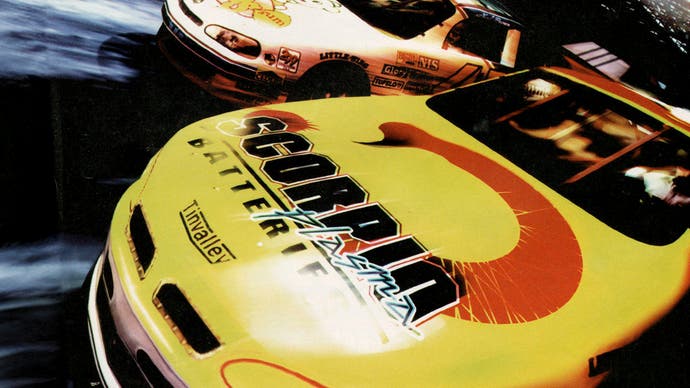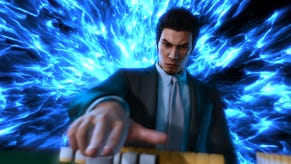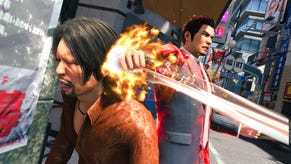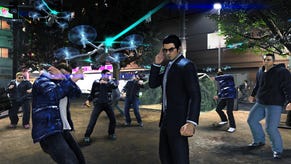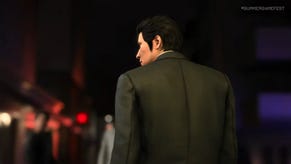Daytona USA 2 is finally available to play at home after 25 years - and it's still brilliant
Model 3 emulation tested within Like a Dragon Gaiden: The Man Who Erased His Name.
Nestled deep in the heart of virtual Yokohama down an ordinary alleyway lies the Sasaki Game Center - a virtual playground celebrating Sega's arcade heritage. The arcade has become a staple of Sega's Like A Dragon series but with the latest series entry, we've reached a new milestone - Sega has finally, for the first time, introduced official Model 3 emulation with it comes one of the finest racing games ever made.
Daytona USA 2: Battle on the Edge - now known, thanks to licensing issues, as Sega Racing Classic 2 - is an arcade racing game from the legendary AM2 and it stands as one of the fastest, most elegantly designed racing games of all time. It's not alone either, as a second Model 3 game is also included - Fighting Vipers 2. Daytona USA 2 has never been available on home consoles before, but Fighting Vipers 2 has in the form of a creditable Dreamcast port, thought to be uncannily similar to its arcade counterpart. But how close is it really? Thanks to Like a Dragon Gaiden: The Man Who Erased His Name, now we can find out.
To understand Sega's Model 3 arcade technology, we need to put 1996 into context. This is the year Nintendo 64 arrived on the market and the year that PlayStation really started to take hold across the industry. It was the year of games like Tekken 2 and Soul Edge, the year of Quake, Tomb Raider, Super Mario 64 and Waverace. On the PC side, the 3DFX Voodoo card arrived on the scene introducing high resolution rendering, faster frame-rates and smooth textures. But then there was Virtua Fighter 3.
This showcase title was developed alongside the new Model 3 arcade hardware and it immediately felt like a jump into the future. The quality and fluidity of the visuals far exceeded anything else that would be released over the next four years. The Model 3 could push huge polygon counts for the time with high resolution textures and genuine anti-aliasing. VF3 itself introduced inverse kinematics allowing proper foot placement on uneven surfaces. The entire thing was a visual feast that blew the doors off everything else both at home and in the arcade. I mean, Tekken 2 is an amazing fighting game, but going from this to this is a generational leap and then some.
Sega would develop many games for Model 3 but, in 1998, we received the sequel to one of Sega's most popular releases - a follow-up to Daytona USA. Daytona 2 is the quintessential arcade racing experience marrying ultra high-tech visuals with a tremendous sense of speed and intensity. Even today, decades after its original release, it feels amazing to hop in the cockpit of one of its stock cars and slingshot your way around the track.
Similar to VF3, it was generations apart from its contemporaries: high-end PCs were delivering games like Need for Speed 3: Hot Pursuit which looked remarkable at the time. In the arcade, Midway's Rush games were contemporary (though pre-date Daytona 2 slightly) but there was also California Speed and numerous others. Gran Turismo was released in the West in 1998 as well redefining expectations for realistic driving simulation on a console. Many of them, even the arcade games, often struggled to maintain even 30 frames per second. When they did hit 60fps, in games such as F-Zero X for N64, detail was stripped back to the minimum.
Yet, if you look back to 1996, Sega had already released SCUD Race in the arcade delivering visuals like this at super smooth frame-rate. It was truly mind-blowing in comparison to games that would ship years later on other hardware. With Daytona 2, however, Sega moved up to a slightly more powerful version of the Model 3 board and delivered a masterclass in high-end visuals. This truly felt like dipping your toes into the future to experience visual quality that had never existed. This was the magic of the arcade - when games were developed on ultra expensive high-end hardware, pushing boundaries at the same time. That AM2 was able to produce games that were both cutting edge yet so strong from a game design perspective will never not impress me.
So the quality of the visuals comes down to a pairing between exceptionally well designed art, including the textures, colors, lighting and modeling in addition to the underlying technology. This allowed Sega to push huge polygon counts - millions of polygons per second - while using high-resolution textures with both filtering and mip-maps. The hardware also supports a form of multitexture known as microtextures which can be used to layer in higher detail across surfaces. Model 3 supports advanced lighting and color blending features as well. All of this is delivered at a blistering frame-rate that never wavers - something we didn't even get from many other arcade racing games of this era. Only Sega and Namco were so focused on hitting this level of fluidity but Sega's boards had the advantage in terms of visual features.
Alas, Daytona USA 2 remained in arcades. Despite Dreamcast releasing not long after, it never received a proper home conversion. There was a Daytona game released for the system but it's more of a spin on the original game. In time, hope was lost and we feared that Daytona 2 would never receive a home conversion. That is - until now.
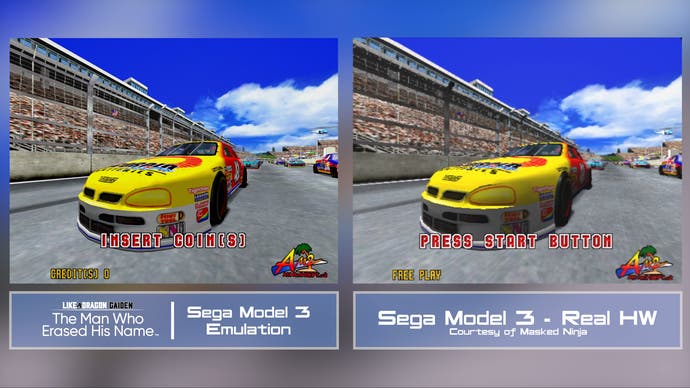
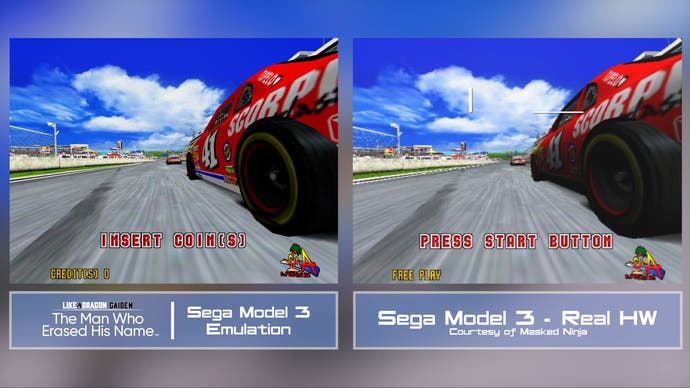

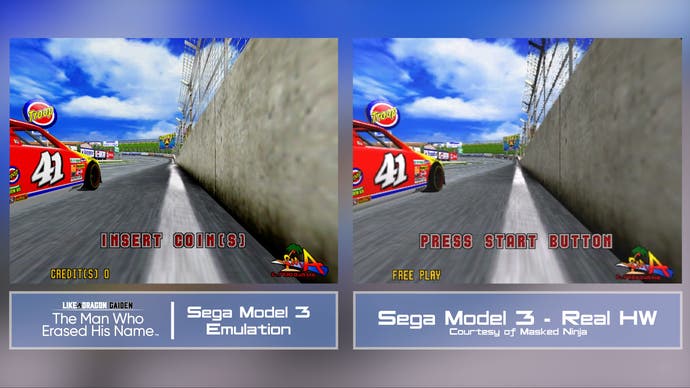
Recently, Sega finally unveiled its own in-house emulator designed to play Model 3 arcade games. Daytona 2 Power Edition is one the two Model 3 games included and, boy, is it great to experience this once again. Firstly, according to various interviews, it seems that this internal Model 3 emulator is largely the work of a single programmer who continued to work on this project, eventually enabling its use within Like A Dragon.
When you fire it up, the first thing you'll notice is that the games are presented in their original 4:3 aspect ratio with a very subtle CRT filter applied to the entire image. There is no option to change this but it works well enough, I suppose. The game is rendered at a higher resolution than the original arcade version's 496x384, however, but Sega does not seem to emulate Model 3's anti-aliasing feature which is likely part of the reason they boosted the resolution. Using the game's introduction, we can draw comparisons between the emulated version and real hardware. Thanks to Masked Ninja on the Supermodel forums, we have genuine capture from a real Model 3 board for comparison.
At a glance, the emulated version appears very accurate indeed - the micro-texture feature is emulated, shadows, lighting, the glare on the car - it's all here. If you look a little closer, however, differences do manifest. Firstly, the car shading is wrong, a graduated darkening on the side of the vehicle completely absent under emulation. It's a minor but interesting nitpick, as are some of the bizarre clipping issues when objects are too close to the camera. This is more apparent when the game cuts to the car interior with the driver's hands and the steering wheel - it clips right through the camera frustum and looks very incorrect. Beyond this, texture filtering is handled differently - it's vastly superior on real Model 3 hardware.
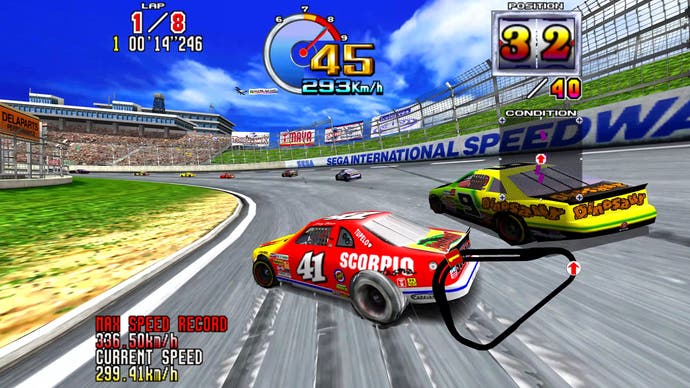
So, while it's not 100 percent accurate, it is still ultimately very close and the experience of playing this exceptional game is fully retained. PC users have access to emulation via Supermodel - and while it's very close, it has its own minor issues, such as an unsatisfactory mapping of steering wheel inputs from analogue controllers. However, the ability to tweak aspect ratio and select arbitrary resolutions is certainly worthwhile.
Ultimately, no matter how you play it, Daytona USA 2 aka Sega Racing Classic 2 has earned its place in the history books for its buttery-smooth gameplay, unwavering frame-rate, flawless handling and powerful soundscape. Every time I drop in a quarter - virtual or otherwise - I can't help but smile. This is a game that brings you joy and I'm appreciative that Sega finally delivered a proper home release. I just hope they eventually consider releasing a standalone package.
Of course, Daytona USA 2 is not alone. The new Like a Dragon also includes an emulated Fighting Vipers 2. The series' debut first arrived back in 1995 for Sega's Model 2 arcade board and shortly after received an excellent port to the Sega Saturn. It's a fast-paced fighter that introduced some unique ideas including breakable armour and contained arenas that could be smashed. The development team would produce Fighters Megamix on Saturn before moving onto a proper sequel known as Fighting Vipers 2. This time, it made use of the Model 3 arcade board delivering enhanced visuals with significantly more geometry and texture detail. It never fully matched the majesty of Virtua Fighter 3, mind you, but it was a handsome game nonetheless.

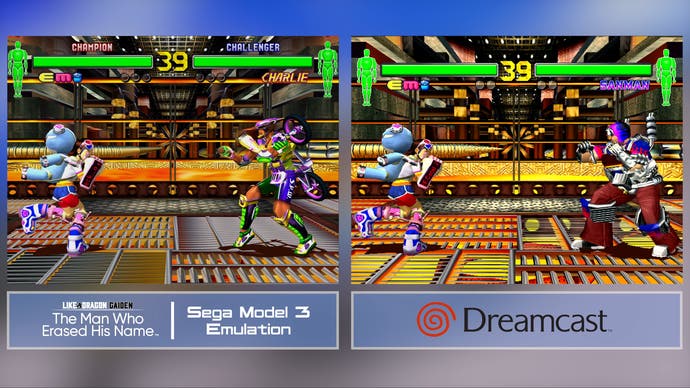
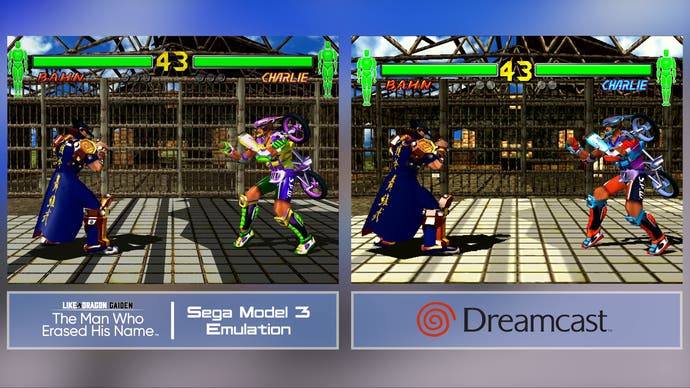

Unlike Daytona 2, however, Fighting Vipers 2 was brought home on Sega Dreamcast - at least in Japan and Europe. Fighting Vipers 2 finally comes home now thanks to Like A Dragon Gaiden and it's included alongside Sega Racing Classic 2 within the game centers. It's the first time we're seeing the actual Model 3 game brought to a home console without compromise. Much like Daytona 2, Fighting Vipers 2 operates in 4:3 with a CRT filter enabled. It also runs at 60 frames per second during gameplay providing fluid motion without judder. It uses the same high-resolution rendering and plays pretty well though with a minor caveat.
I should note that I did not have access to capture from a real Fighting Vipers 2 board and, in fact, have never played this game in an actual arcade, so I can't judge it to the same standard as Daytona 2. What we can do, however, is compare and contrast with the Sega Dreamcast version. I had always assumed the Dreamcast version was, more or less, arcade-accurate. It had a reputation for being better than the disappointing Dreamcast port of Virtua Fighter 3tb but after sampling the game via Like A Dragon, it turns out there are elements missing on Dreamcast.
For starters, there's geometry - the Dreamcast game was scaled back in this regard with less complex arenas and subtle changes to characters. Character textures are of a higher resolution on Model 3 and shadows are drawn completely differently. Furthermore, background texture work is of a much lower res on Dreamcast as well. There are other compromises on Dreamcast too: for example, in one area, there are modelled polygonal grates on the floor with the Model 3 version whereas the Dreamcast uses alpha textures instead. That's not to say the Dreamcast port is bad - for the time, it's very close - it's just I was surprised to see the areas where it falls short considering its reputation as being 'arcade perfect'.
Fighting Vipers 2 is a weird one overall, though. It's a fun game but it's not among my favorite Sega arcade titles from this era. However, I do appreciate seeing it preserved here within Like A Dragon and, as with Daytona 2, the emulation seems to be quite good. And while the fighting game genre is still represented in modern gaming, I've often lamented the slow disappearance of the arcade racer on today's systems. However, the re-emergence of Daytona, at least in some form, does at least give me a glimmer of hope. Someone deep within Sega still clearly cares.
Not only that, it's great to see Sega honouring its incredible Model 3 technology - not to mention the unrivalled arcade genius of development studio AM2. The emulation isn't flawless but it's more than good enough and sets the stage for future releases. Couple this with the announcement of Virtua Fighter 3tb making a return to Japanese arcades and it seems that, perhaps, Sega is finally ready to thrust open the doors of history once more. Model 3 was a defining era for Sega and some might suggest, the last great hurrah for cutting-edge technology in its mighty arcade releases.
And while we celebrate the arrival of Daytona USA 2 and Fighting Vipers 2 today, many questions remain unanswered. Will Sega ever get around to releasing Model 1, Model 2 and Model 3 retro collections? Will other unported classics - like Scud Race, for example - finally come home in a future Like A Dragon game? The games are there. The quality is there. And now we know that the emulation is good enough too. Over to you, Sega.
